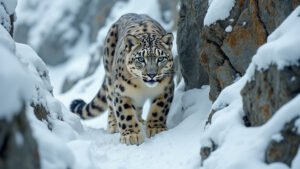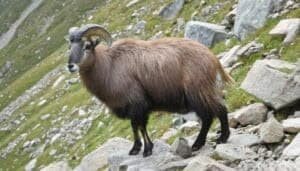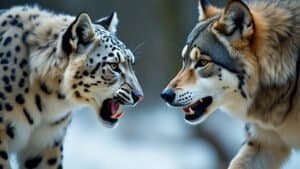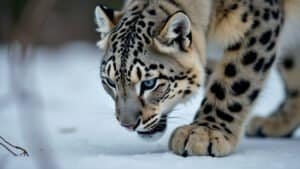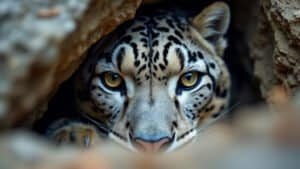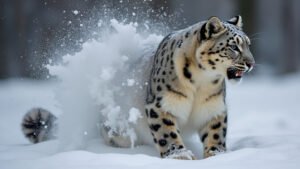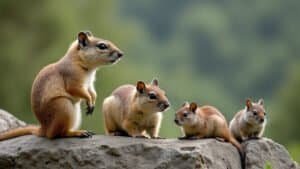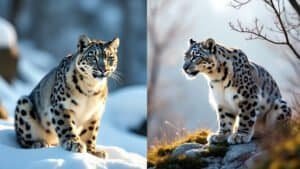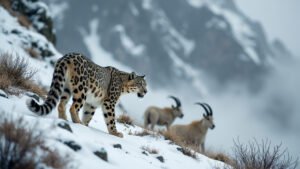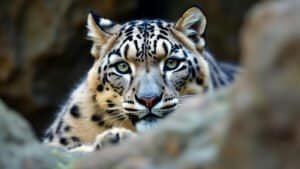Introduction
The diet of snow leopards, elusive predators of the high mountains, is a subject of ongoing research, particularly regarding the role of birds as prey. While snow leopards are known to primarily hunt mammals, birds can also play a crucial part in their diet, especially in regions where other prey is scarce
This article will delve into the specific types of birds targeted by snow leopards, the frequency and circumstances under which these predators consume avian prey, and how birds contribute to the nutritional needs of snow leopards
We will also explore the hunting strategies employed by snow leopards to capture birds and the seasonal and regional variations in their diet
Types of Birds Preyed Upon by Snow Leopards
Snow leopards, primarily known for their preference for medium to large-sized mammals like blue sheep and ibex, occasionally turn to birds as a supplementary food source
The specific types of birds that snow leopards prey upon vary depending on the region, availability, and environmental conditions. Although not a primary food source, birds can be crucial, particularly in regions where larger prey is scarce or during specific seasons when mammalian prey is less accessible
Common Avian Species in the Snow Leopard’s Diet
The types of birds that snow leopards hunt are generally medium-sized and those that inhabit the same high-altitude environments
In the Himalayas, for example, snow leopards have been documented preying on chukar partridges (Alectoris chukar), which are ground-dwelling birds common in rocky terrains. These birds are relatively easy prey due to their ground-nesting habits and lower flight capabilities compared to other avian species
In the Tien Shan mountains of Central Asia, another common avian prey is the Himalayan snowcock (Tetraogallus himalayensis). These birds are large, ground-dwelling birds, similar to the chukar, and they occupy high-altitude regions where snow leopards are prevalent
Their large size makes them a more substantial meal, providing the necessary nutrients that a large carnivore like the snow leopard requires
Regional Variations in Avian Prey
The specific bird species targeted by snow leopards can vary significantly across different regions of their range, which spans from the Russian Altai Mountains in the north to the Himalayan foothills in the south
In the Pamir Mountains of Tajikistan, for instance, snow leopards have been observed preying on species like the Tibetan snowcock (Tetraogallus tibetanus), which is adapted to the arid and cold environments of Central Asia. This bird is similar in size and behavior to the Himalayan snowcock, making it a viable prey option for the snow leopards of this region
In addition to these ground-dwelling species, snow leopards may also hunt smaller birds, such as the rock pigeons (Columba livia), which are often found in and around human settlements in the mountainous regions
While not a significant part of their diet, these birds can become targets of opportunity, especially in areas where other prey is not readily available
Unique Bird Species Snow Leopards Target
In certain regions, snow leopards may also prey on more unique or less common bird species
For example, in the Karakoram range, snow leopards have been known to hunt the Himalayan monal (Lophophorus impejanus), a brightly colored pheasant-like bird that is more elusive and difficult to catch. The monal’s presence in the snow leopard’s diet highlights the predator’s adaptability and ability to exploit a wide range of prey when necessary
Moreover, during times of extreme scarcity, snow leopards might even target migratory birds passing through their territory. These instances are less documented but indicate the opportunistic nature of snow leopards when faced with limited food sources
Frequency of Bird Consumption in Snow Leopard Diet
While snow leopards are predominantly known for hunting mammals, the frequency with which they consume birds varies based on factors such as prey availability, seasonal changes, and environmental conditions
Understanding how often birds form a part of the snow leopard’s diet can provide insights into the adaptability and survival strategies of these elusive predators
Dietary Studies and Findings
Scientific studies focused on the diet of snow leopards reveal that birds generally constitute a small but significant portion of their overall food intake
Research conducted in the Central Himalayas by Sharma et al. (2020) found that avian prey accounted for about 5-10% of the snow leopard’s diet, with the rest primarily composed of larger mammals like blue sheep and argali. This percentage, though seemingly minor, can be crucial during times when larger prey is scarce
In another study from the Tien Shan Range, Galsang et al. (2017) observed that birds made up approximately 7% of the snow leopard’s diet during the summer months
This increase was attributed to the seasonal abundance of birds during this period, which coincides with the breeding season of many avian species, making them more accessible to predators
Comparison with Other Prey
Compared to mammals, birds are less frequently consumed by snow leopards. Mammalian prey, particularly ungulates, typically provides more sustenance per kill, which is essential for the energy demands of a large predator
However, birds can be an important supplementary food source, especially in environments where mammalian prey densities are low
For example, during the winter months, when smaller mammals may hibernate or be less active, snow leopards may increase their reliance on birds. This shift in diet is not only opportunistic but also reflects the snow leopard’s ability to adapt to seasonal variations in prey availability
Although the percentage of bird consumption remains lower than that of mammals, it becomes more pronounced in certain regions and seasons
Factors Influencing Bird Consumption
Several factors influence the frequency of bird consumption by snow leopards, including prey availability, habitat, and the predator’s hunting success
In regions where large mammals are scarce due to overhunting or habitat degradation, snow leopards may turn more frequently to smaller prey, including birds. Additionally, younger or less experienced snow leopards might target birds more often, as they are easier to catch compared to more challenging mammalian prey
Environmental conditions also play a significant role. In areas with harsh winters and deep snow, snow leopards might find it easier to hunt birds that remain active or are less able to escape due to the difficult terrain
This is particularly relevant in regions like the Pamirs and parts of the Himalayas, where snow coverage can limit the movement of both predators and prey
Another factor is the availability of nesting sites for birds. Snow leopards are more likely to prey on ground-nesting birds or those that inhabit rocky outcrops, which are more accessible in their mountainous habitats. The presence of these nesting sites can increase the frequency with which snow leopards include birds in their diet
Hunting Techniques of Snow Leopards for Birds
Snow leopards are well-adapted hunters, known for their stealth and ability to navigate rugged terrains. When it comes to hunting birds, these big cats employ a variety of techniques that leverage their physical prowess and environmental knowledge
Although birds are not their primary prey, snow leopards demonstrate remarkable adaptability in their hunting strategies to capture these agile targets
Stalking and Ambush Strategies
Snow leopards are primarily ambush predators, relying on their camouflaged fur and silent movement to get close to their prey before launching an attack. This technique is particularly effective when hunting birds, especially ground-dwelling species like the chukar partridge or Himalayan snowcock
The leopard will stalk its prey by staying low to the ground and moving slowly, using rocks, bushes, and other natural features as cover. Once within striking distance, the snow leopard will pounce with a sudden burst of speed, aiming to catch the bird off guard
In some cases, snow leopards may use the terrain to their advantage, driving birds towards natural traps or using the element of surprise to their benefit. For example, they might wait near a cliff edge or rocky outcrop where birds are known to nest or feed, reducing the bird’s escape routes and increasing the chances of a successful hunt
Adapting to Bird Habitats
The high-altitude habitats where snow leopards are found are also home to several bird species that are well-adapted to these environments
Snow leopards have evolved to exploit these specific habitats, using their exceptional climbing abilities to reach birds that nest on steep cliffs or rocky ledges. This adaptability allows them to hunt birds that other predators might find difficult to access
In addition to their physical adaptations, snow leopards also exhibit behavioral flexibility. They may alter their hunting patterns depending on the time of day and the activity patterns of their avian prey
For instance, snow leopards might hunt during the early morning or late evening when birds are most active and feeding, thereby increasing their chances of a successful hunt
Case Studies of Bird Hunts
Several documented cases provide insight into the specific hunting techniques snow leopards use when targeting birds
One study in the Karakoram range observed a snow leopard successfully hunting a Himalayan monal, a large and brightly colored pheasant. The snow leopard employed a patient stalking approach, moving slowly and carefully through dense underbrush until it was within range. The final attack was a swift pounce that left the bird with little chance of escape
Another instance involved a snow leopard in the Tien Shan mountains using the element of surprise to capture a Tibetan snowcock. The leopard waited near a known feeding ground, remaining hidden among the rocks until the birds had settled to feed
When the moment was right, the snow leopard sprang from its hiding spot, taking advantage of the birds’ momentary distraction to secure its prey
These cases illustrate the snow leopard’s ability to adapt its hunting techniques to different types of prey, including birds. Whether through stalking, ambush, or exploiting the landscape, snow leopards demonstrate a high level of skill and versatility in hunting, which is essential for survival in the harsh and often unforgiving environments they inhabit
Nutritional Impact of Birds on Snow Leopards
While birds do not constitute the primary diet of snow leopards, they still provide essential nutrients that contribute to the predator’s overall health and survival
The nutritional value of avian prey, although generally lower than that of larger mammals, can play a significant role in the snow leopard’s diet, particularly during times of food scarcity
Nutritional Content of Avian Prey
Birds offer a different nutritional profile compared to the larger mammals that snow leopards typically hunt
While they are smaller and provide less caloric intake, birds are rich in protein and essential fats, which are crucial for the snow leopard’s energy needs, particularly in the cold, high-altitude environments where these predators live
For example, the breast meat of birds like chukar partridges and Himalayan snowcocks is lean yet dense in protein, offering a quick and efficient source of energy
The consumption of birds also provides snow leopards with micronutrients such as calcium and phosphorus, which are vital for bone health, particularly in growing cubs. These nutrients are often derived from the consumption of bird bones and feathers, which snow leopards, like other big cats, are capable of digesting to some extent
The presence of these smaller prey items in their diet helps diversify their nutrient intake, which is beneficial in an environment where food availability can be unpredictable
Importance in Survival During Scarcity
In regions where larger prey is scarce or during certain times of the year when hunting large mammals becomes more challenging, birds can become a more important component of the snow leopard’s diet
For instance, during the harsh winter months, when snow coverage limits the movement of large ungulates, snow leopards may increase their reliance on birds that are still active and available. This shift, although temporary, can be critical for the snow leopard’s survival during these lean periods
The flexibility to include birds in their diet reflects the snow leopard’s adaptive strategies in dealing with fluctuating food resources
In ecosystems where prey populations are in decline due to factors such as overhunting or habitat loss, birds might serve as a more consistent food source, ensuring that the snow leopard can maintain its energy levels and reproductive success
Comparing Nutritional Value with Mammalian Prey
When compared to mammals, birds generally offer a lower caloric return. A single large mammalian prey like a blue sheep can provide several days’ worth of food, whereas birds, due to their smaller size, are more likely to be consumed in a single meal
However, the ease of catching birds and their availability in certain regions and seasons make them a valuable supplemental food source
Additionally, birds may be easier to catch and require less energy expenditure than hunting larger, more challenging prey. This energy efficiency is particularly important for snow leopards, who inhabit some of the most rugged and energy-demanding environments on Earth
The ability to catch and consume birds with relatively little effort compared to chasing down larger mammals can be advantageous, especially when conserving energy is crucial
Seasonal and Regional Variations in Bird Consumption
The diet of snow leopards, including the consumption of birds, is not static but varies depending on seasonal changes and regional differences. These variations are influenced by factors such as prey availability, environmental conditions, and the migratory patterns of birds
Understanding these fluctuations helps in comprehending how snow leopards adapt to the dynamic nature of their habitats
Impact of Seasonal Changes on Diet
Snow leopards experience significant seasonal shifts in their environment, which in turn affect their diet
During the warmer months, when the snow melts and vegetation flourishes, there is generally a higher availability of mammalian prey such as ibex, blue sheep, and marmots. As a result, the reliance on birds as a food source typically decreases during this time
However, during the winter months, when deep snow covers the ground and many mammals either migrate to lower altitudes or become less active, snow leopards may increase their consumption of birds
Studies, such as the one conducted by Thapa et al. (2021) in the Himalayas, indicate that during winter, birds like the chukar partridge and snowcock become more prominent in the snow leopard’s diet. The harsh conditions make these birds, which remain active and accessible, more attractive targets
Seasonal migration of certain bird species can also influence their availability to snow leopards. For example, migratory birds passing through or wintering in snow leopard territories may temporarily increase the availability of avian prey, leading to a seasonal spike in bird consumption
How Regional Ecosystems Influence Prey Availability
The geographical range of snow leopards extends across several countries, each with its own unique ecosystem. These regional differences significantly influence the availability of bird species and other prey
In the Central Asian ranges like the Tien Shan and the Pamirs, the snow leopard’s diet may include a higher proportion of birds like the Tibetan snowcock and Himalayan snowcock, which are abundant in these regions
In contrast, snow leopards living in the more densely vegetated regions of the Eastern Himalayas might have a different dietary composition, with a reduced reliance on birds due to the higher availability of mammalian prey. In these areas, the presence of large forests and varied wildlife offers a more consistent supply of mammalian prey, reducing the need to hunt birds
Regional human activity also plays a role. In areas where human encroachment has reduced mammalian prey through hunting or habitat destruction, snow leopards may turn to birds and smaller mammals more frequently. This adaptation showcases the snow leopard’s resilience and ability to survive in increasingly fragmented habitats
Migration Patterns and Snow Leopard Hunting
Bird migration patterns can significantly impact the availability of avian prey for snow leopards. During migration seasons, especially in regions that serve as migratory corridors, snow leopards might take advantage of the increased bird population
For example, migratory birds that pass through the mountains of Central Asia could provide a temporary but abundant food source, particularly during late autumn or early spring when other prey might be less accessible
The ability of snow leopards to exploit these migratory birds illustrates their opportunistic hunting behavior. In regions like the Altai Mountains, where snow leopards might encounter flocks of migratory waterfowl or passerines, they could temporarily adjust their hunting strategies to take advantage of this influx of prey
However, the predictability of bird migrations also means that these food sources are temporary, requiring snow leopards to constantly adapt to changing prey availability throughout the year. This dynamic feeding behavior highlights the snow leopard’s remarkable adaptability to both temporal and spatial variations in prey availability
Conclusion
Snow leopards, often considered one of the most elusive predators, exhibit remarkable adaptability in their diet, which includes a small but significant proportion of birds
While their primary prey consists of larger mammals like blue sheep and ibex, birds such as chukar partridges and Himalayan snowcocks play an important supplementary role, particularly during times of scarcity or in regions where mammalian prey is less available
The frequency of bird consumption varies based on seasonal changes, with a higher reliance on avian prey during harsh winter months when other prey is less accessible
Snow leopards employ various hunting techniques to capture birds, including stalking and ambushing, often taking advantage of the rugged terrain to trap their prey. The nutritional impact of these birds, while not as substantial as that of larger mammals, provides essential proteins, fats, and micronutrients that contribute to the snow leopard’s survival in its demanding environment
Additionally, regional differences in ecosystem and human activity further influence the availability of avian prey, underscoring the snow leopard’s ability to adapt to diverse and changing conditions


